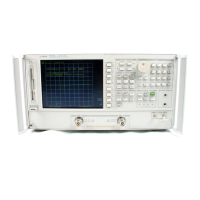2
Making
Measurements
This Chapter contains the following example procedures for making measurements or using
particular functions:
n
Basic measurement sequence and example
0 Setting frequency range
0 Setting source power
w
Analyzer display functions
n
Four-Parameter Display Mode
w
Analyzer marker functions
n
Magnitude and insertion phase response
n
Electrical length and phase distortion
q
Deviation from linear phase
q
Group delay
n
Limit testing
n
Gain compression
w
Gain and reverse isolation
n
Measurements using the swept list mode
n
Tuned Receiver Mode
n
Test
sequencing
n
Measuring Swept Harmonics
n
Time domain
0
Transmission response
q
Reflection response
n
Non-coaxial measurements
Where to Look for More Information
Additional information about many of the topics discussed
in
this Chapter is located in the
following areas:
n
Chapter 4, “Printing, Plotting, and Saving Measurement Results,” contains instructions
for saving to disk or the analyzer internal memory, and printing and plotting displayed
measurements.
n
Chapter 5, “Optimizing Measurement Results,” describes techniques and functions for
achieving the best measurement results
n
Chapter 6, “Application and Operation Concepts,
n
contains explanatory-style information
about many applications and analyzer operation.
w
Chapter 9, “Key Definitions,” describes all the front panel keys and softkeys.
n
Chapter 11, “Compatible Peripherals,” lists measurement and system accessories, and other
applicable equipment compatible with the analyzer.
Making Measurements
2-l

